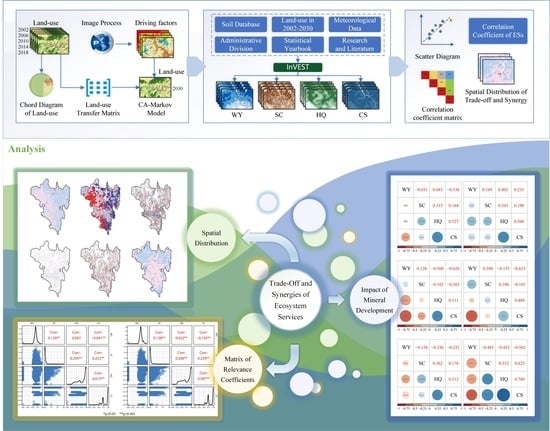Evaluating Trade-Off and Synergies of Ecosystem Services Values of a Representative Resources-Based Urban Ecosystem: A Coupled Modeling Framework Applied to Panzhihua City, China
Abstract
1. Introduction
2. Study Area
3. Materials and Methods
3.1. Data Sources
3.2. Methodology
3.2.1. Land Use Dynamic Change and Forecast
- (1)
- CA Model
- (2)
- Markov Model
- (3)
- CA–Markov Model
3.2.2. Ecosystem Services Assessment
- (1)
- Water Yield
- (2)
- Soil Conservation
- (3)
- Habitat Quality
- (4)
- Carbon Storage and Sequestration
3.2.3. Correlation Analysis
4. Results
4.1. Spatial and Temporal Changes in Land Use
4.2. Land Use Forecast Analysis
4.3. Spatial and Temporal Analysis of Ecosystem Services
4.4. Spatio-Temporal Analysis of Trade-Offs and Analysis of Ecosystem Services
4.4.1. Spatial and Temporal Analysis of Ecosystem Services
4.4.2. Spatial Analysis of Ecosystem Service Trade-Offs and Synergies
4.5. Impact of Mineral Development on Ecosystem Services
5. Discussion
5.1. Model Selection and Parameter Modification
5.2. Assessment of Ecosystem Services and Exploration of Land Use Impacts
5.3. Exploration of the Impact of Mineral Species on Ecosystem Services
5.4. Uncertainty Analysis
- The unsuitable arable land in the central region is supposed to be returned to forest and grass, and the mining area should be reasonably balanced between mining and replanting.
- Relevant authorities need to increase the construction of wetland systems, improve functional integrity, achieve synergy of multiple ecosystem services from multiple perspectives, and regulate trade-offs to build a healthier ecosystem.
- Most forest vegetation types in the northern part of the study area are homogeneous, and the trade-offs are more prominent. Therefore, enriching the vegetation types is necessary to improve them, enhance ecosystem stability, and promote sustainable development.
5.5. Applicability and Extension of the Model
6. Conclusions
- (1)
- From 2002 to 2018, land use in Panzhihua has undergone dramatic changes. Cropland, water, and impervious surfaces continue to expand, and new agricultural land mainly comes from the conversion of forests and grasslands. As a result, the area of ecological lands such as forests and grasslands has decreased, and the rate of reduction has slowed down yearly. While agricultural and rural construction are vigorously developing, the conservation of ecological green areas should also be promoted.
- (2)
- The results of the ecosystem service assessment using the InVEST model showed a high degree of confidence. Water production, habitat quality, and carbon storage services have all declined, and water production services are predicted to improve in 2030. Nevertheless, the ecological condition in the economically active central part of Panzhihua is the worst, and attention needs to be paid to the adverse environmental effects of rapid urban development.
- (3)
- Synergistic relationships among ecosystem services dominate, with the most significant synergistic relationship being between habitat quality and carbon storage. Weak trade-off relationships appear between water production and soil conservation and habitat quality services, and the trade-off relationship between water production and habitat quality services is weakening. Ecosystem services in Panzhihua are gradually moving towards coordination, and ecological construction has a positive and important impact on maintaining ecosystem stability.
- (4)
- There are many trade-offs between ecosystem services in mining areas, with strong trade-offs occurring between water production and carbon storage services. Coal and iron ore mines have the most negligible impact on ecosystem services, while clay mines have the greatest impact. The effects of mining areas on ecosystem services should not be underestimated, and there is heterogeneity in the impact of different mining areas on ecosystem services. Combining ecosystem services to optimize mineral development is of great significance in achieving a win–win situation for ecology and mining.
- (5)
- A hierarchy of ecosystem service synergies and trade-offs was established. Spatially, the pattern of relationships between water yield services and soil conservation and habitat quality services showed trade-offs in the east and synergies in the west. The trade-offs between carbon storage services, water production, and habitat quality services were more significant in urban areas.
Author Contributions
Funding
Data Availability Statement
Conflicts of Interest
Appendix A
| Period | LUCC | Impervious | Grassland | Shrub | Barren | Cropland | Forest | Water |
|---|---|---|---|---|---|---|---|---|
| 2002–2006 | Impervious | 1638.36 | 212.22 | 39.6 | 247.05 | 10.08 | 31.95 | |
| Grassland | 54,342.81 | 599.76 | 19.35 | 5658.66 | 12.78 | 40.95 | ||
| Shrub | 1292.31 | 18,887.04 | 1963.44 | 2263.68 | ||||
| Barren | 9.63 | 137.61 | 5.94 | |||||
| Cropland | 4384.08 | 1211.13 | 0.27 | 136,341.09 | 9632.61 | 46.89 | ||
| Forest | 1101.96 | 1942.38 | 2909.34 | 486,843.75 | 10.17 | |||
| Water | 69.66 | 106.38 | 10.53 | 223.38 | 6887.7 | |||
| 2006–2010 | Impervious | 2102.4 | 196.38 | 10.98 | 368.1 | 4.14 | 28.53 | |
| Grassland | 49,517.73 | 1325.97 | 18.81 | 3845.7 | 39.87 | 48.96 | ||
| Shrub | 407.16 | 19,203.03 | 848.16 | 1837.8 | ||||
| Barren | 24.21 | 110.16 | 11.07 | |||||
| Cropland | 0.27 | 9446.76 | 2435.4 | 0.81 | 144,111.06 | 12,948.39 | 36.63 | |
| Forest | 981.09 | 1442.07 | 2283.57 | 477,977.22 | 9.18 | |||
| Water | 76.59 | 100.98 | 12.42 | 159.48 | 0.18 | 7163.28 | ||
| 2010–2014 | Impervious | 2675.79 | 30.87 | 14.58 | 101.25 | 0.72 | 23.76 | |
| Grassland | 42,743.43 | 1266.21 | 24.3 | 4984.38 | 20.79 | 40.41 | ||
| Shrub | 475.56 | 17,154.36 | 1193.58 | 5050.8 | ||||
| Barren | 24.12 | 97.02 | 0.27 | 4.41 | ||||
| Cropland | 9917.28 | 3354.12 | 0.36 | 160,203.42 | 15,181.92 | 67.41 | ||
| Forest | 1434.06 | 521.37 | 2356.02 | 462,438.9 | 1.17 | |||
| Water | 34.74 | 171.72 | 0.09 | 9.18 | 140.4 | 7375.77 | ||
| 2014–2018 | Impervious | 2807.28 | 63.09 | 7.92 | 70.11 | 1.17 | 17.1 | |
| Grassland | 39,702.87 | 580.23 | 40.23 | 5135.58 | 12.06 | 66.33 | ||
| Shrub | 811.8 | 19,399.59 | 1425.15 | 3173.04 | ||||
| Barren | 1.53 | 63.72 | 0.45 | |||||
| Cropland | 7450.92 | 2706.21 | 1.08 | 178,431.12 | 8616.6 | 66.24 | ||
| Forest | 900.09 | 1188.27 | 3506.67 | 454,948.65 | 1.62 | |||
| Water | 39.69 | 149.22 | 12.87 | 155.88 | 7580.16 |
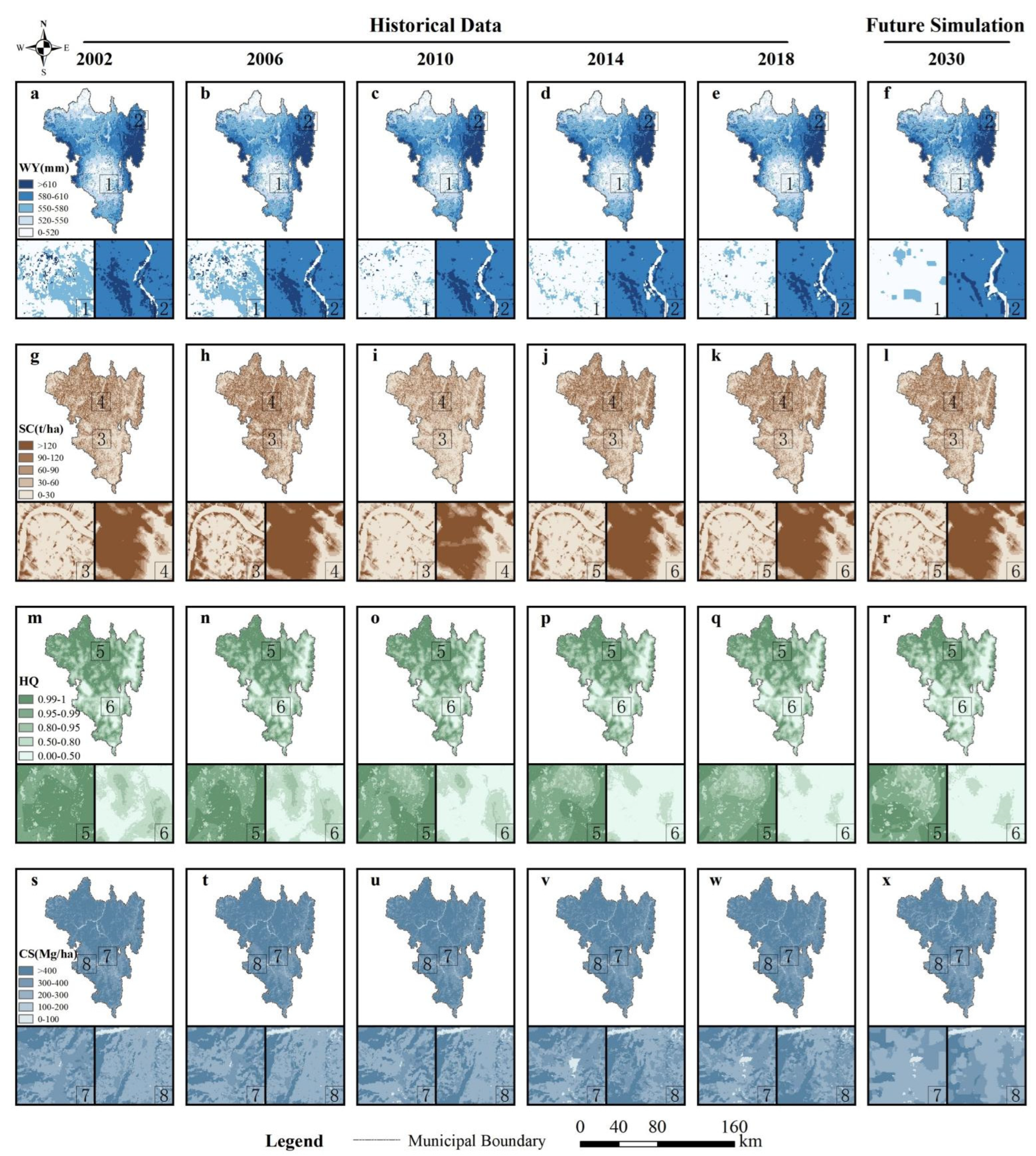
References
- Xie, G.; Zhang, C.; Zhang, L.; Chen, W.; Li, S. Improvement of the evaluation method for ecosystem service value based on per unit area. J. Nat. Resour. 2015, 30, 1243–1254. [Google Scholar]
- Chen, W.; Zhao, H.; Li, J.; Zhu, L.; Wang, Z.; Zeng, J. Land use transitions and the associated impacts on ecosystem services in the Middle Reaches of the Yangtze River Economic Belt in China based on the geo-informatic Tupu method. Sci. Total Environ. 2020, 701, 134690. [Google Scholar] [CrossRef] [PubMed]
- Xie, G.; Lu, C.; Cheng, S. Progress in evaluating the global ecosystem services. Resour. Sci. 2001, 23, 5–9. [Google Scholar]
- Costanza, R.; d’Arge, R.; de Groot, R.; Farber, S.; Grasso, M.; Hannon, B.; Limburg, K.; Naeem, S.; O’Neill, R.V.; Paruelo, J.; et al. The value of the world’s ecosystem services and natural capital. Nature 1997, 387, 253–260. [Google Scholar] [CrossRef]
- Xie, G.; Zhang, C.; Zhang, C.; Xiao, Y.; Lu, C. The value of ecosystem services in China. Resour. Sci. 2015, 37, 1740–1746. [Google Scholar]
- Ouyang, Z.; Wang, X.; Miao, H. A primary study on Chinese terrestrial ecosystem services and their ecological-economic values. Acta Ecol. Sinca 1999, 19, 607–613. [Google Scholar]
- Zhao, J.; Xiao, H.; Wu, G. Comparison analysis on physical and value assessment methods for ecosystem services. Chin. J. Appl. Ecol. 2000, 11, 290–292. [Google Scholar] [CrossRef]
- Li, W.; Zhao, B.; Xu, Q.; Scaringi, G.; Lu, H.; Huang, R. More frequent glacier-rock avalanches in Sedongpu gully are blocking the Yarlung Zangbo River in eastern Tibet. Landslides 2022, 19, 589–601. [Google Scholar] [CrossRef]
- Fu, B.; Zhang, L. Land-use change and ecosystem services: Concepts, methods and progress. Prog. Geogr. 2014, 33, 441–446. [Google Scholar]
- Yao, Y.; Tian, H.; Pan, S.; Najjar, R.G.; Friedrichs, M.A.; Bian, Z.; Li, H.Y.; Hofmann, E.E. Riverine Carbon Cycling Over the Past Century in the Mid-Atlantic Region of the United States. J. Geophys. Res. Biogeosci. 2021, 126, e2020JG005968. [Google Scholar] [CrossRef]
- Dai, X.; Johnson, B.A.; Luo, P.; Yang, K.; Dong, L.; Wang, Q.; Liu, C.; Li, N.; Lu, H.; Ma, L.; et al. Estimation of Urban Ecosystem Services Value: A Case Study of Chengdu, Southwestern China. Remote Sens. 2021, 13, 207. [Google Scholar] [CrossRef]
- Huang, C.; Yang, J.; Zhang, W. Development of ecosystem services evaluation models: Research progress. Chin. J. Ecol. 2013, 32, 3360–3367. [Google Scholar] [CrossRef]
- Dai, E.; Wang, X.; Zhu, J.; Zhao, D. Methods, tools and research framework of ecosystem service trade-offs. Geogr. Res. 2016, 35, 1005–1016. [Google Scholar]
- Yu, X.; Zhou, B.; Lu, X.; Yang, Z. Evaluation of water conservation function in mountain forest areas of Beijing based on InVEST model. Sci. Silvae Sin. 2012, 48, 1–5. [Google Scholar]
- Xiang, L.; Zhaoshun, L.; Shujie, L.; Yingxue, L. Multi-Scenario Simulation Analysis of Land Use Impacts on Habitat Quality in Tianjin Based on the PLUS Model Coupled with the InVEST Model. Sustainability 2022, 14, 6923. [Google Scholar]
- Li, M.; Liang, D.; Xia, J.; Song, J.; Cheng, D.; Wu, J.; Cao, Y.; Sun, H.; Li, Q. Evaluation of water conservation function of Danjiang River Basin in Qinling Mountains, China based on InVEST model. J. Environ. Manag. 2021, 286, 112212. [Google Scholar] [CrossRef]
- Abera, W.; Tamene, L.; Kassawmar, T.; Mulatu, K.; Kassa, H.; Verchot, L.; Quintero, M. Impacts of land use and land cover dynamics on ecosystem services in the Yayo coffee forest biosphere reserve, southwestern Ethiopia. Ecosyst. Serv. 2021, 50, 101338. [Google Scholar] [CrossRef]
- Li, Y.; Luo, Y.; Liu, G.; Ouyang, Z.; Zheng, H. Effects of land use change on ecosystem services: A case study in Miyun reservior watershed. Acta Ecol. Sin. 2013, 33, 726–736. [Google Scholar]
- Bao, Y.; Liu, K.; Li, T.; Hu, S. Effects of land use change on habitat based on InVEST model. Arid. Zone Res. 2015, 32, 622–629. [Google Scholar] [CrossRef]
- Baixue, W.; Weiming, C. Effects of Land Use/Cover on Regional Habitat Quality under Different Geomorphic Types Based on InVEST Model. Remote Sens. 2022, 14, 1279. [Google Scholar]
- Wang, Y.; Ye, A.; Peng, D.; Miao, C.; Di, Z.; Gong, W. Spatiotemporal variations in water conservation function of the Tibetan Plateau under climate change based on InVEST model. J. Hydrol. Reg. Stud. 2022, 41, 101064. [Google Scholar] [CrossRef]
- Pan, T.; Wu, S.; Dai, E.; Liu, Y. Spatiotemporal variation of water source supply services inThree Rivers Source Area of China based on InVEST model. Chin. J. Appl. Ecol. 2013, 24, 183–189. [Google Scholar] [CrossRef]
- Mertens, B.; Lambin, E.F. Land-Cover-Change Trajectories in Southern Cameroon. Ann. Assoc. Am. Geogr. 2010, 90, 467–494. [Google Scholar] [CrossRef]
- Lu, H.; Liu, C.; Li, N.; Fu, X.; Li, L. Optimal segmentation scale selection and evaluation of cultivated land objects based on high-resolution remote sensing images with spectral and texture features. Environ. Sci. Pollut. Res. 2021, 28, 27067–27083. [Google Scholar] [CrossRef] [PubMed]
- Lu, H.; Fu, X.; Liu, C.; Li, L.-G.; He, Y.-X.; Li, N.-W. Cultivated land information extraction in UAV imagery based on deep convolutional neural network and transfer learning. J. Mt. Sci. 2017, 14, 731–741. [Google Scholar] [CrossRef]
- Gao, P.; Wang, H.; Cushman, S.A.; Cheng, C.; Song, C.; Ye, S. Sustainable land-use optimization using NSGA-II: Theoretical and experimental comparisons of improved algorithms. Landsc. Ecol. 2020, 36, 1877–1892. [Google Scholar] [CrossRef]
- Zhang, X.; Liang, J. Study on chande of urban land-use and forrecasting model. Acta Sci. Nat. Univ. Sunyatseni 2004, 43, 121–125. [Google Scholar]
- Batty, M.; Xie, Y. From Cells to Cities. Environ. Plan. B Plan. Des. 1994, 21, S31–S48. [Google Scholar] [CrossRef]
- Wu, F.; Webster, C.J. Simulation of Land Development through the Integration of Cellular Automata and Multicriteria Evaluation. Environ. Plan. B: Plan. Des. 1998, 25, 103–126. [Google Scholar] [CrossRef]
- Clarke, K.C.; Hoppen, S.; Gaydos, L. A Self-Modifying Cellular Automaton Model of Historical Urbanization in the San Francisco Bay Area. Environ. Plan. B: Plan. Des. 1997, 24, 247–261. [Google Scholar] [CrossRef]
- White, R.; Engelen, G.; Uljee, I. The Use of Constrained Cellular Automata for High-Resolution Modelling of Urban Land-Use Dynamics. Environ. Plan. B Plan. Des. 1997, 24, 323–343. [Google Scholar] [CrossRef]
- Matlhodi, B.; Kenabatho, P.K.; Parida, B.P.; Maphanyane, J.G. Analysis of the Future Land Use Land Cover Changes in the Gaborone Dam Catchment Using CA-Markov Model: Implications on Water Resources. Remote Sens. 2021, 13, 2427. [Google Scholar] [CrossRef]
- Xiao, M.; Wu, J.; Chen, Q.; Jin, M.; Hao, X.; Zhang, Y. Dynamic changer of land use in Changhua downstream watershad based on CA-Markov model. Trans. Chin. Soc. Agric. Eng. 2012, 28, 231–238. [Google Scholar]
- Yang, G.; Liu, Y.; Wu, Z. Analysis and simulation of land-use temporal and spatial pattern baqsed on CA-Markov model. Geomat. Inf. Sci. Wuhan Univ. 2007, 32, 414–418. [Google Scholar]
- Song, Q.; Hu, B.; Peng, J.; Bourennane, H.; Biswas, A.; Opitz, T.; Shi, Z. Spatio-temporal variation and dynamic scenario simulation of ecological risk in a typical artificial oasis in northwestern China. J. Clean. Prod. 2022, 369, 133302. [Google Scholar] [CrossRef]
- Bennett, E.M.; Peterson, G.D.; Gordon, L.J. Understanding relationships among multiple ecosystem services. Ecol. Lett. 2009, 12, 1394–1404. [Google Scholar] [CrossRef]
- Rodríguez, J.P.; Beard, T.D., Jr.; Bennett, E.M.; Cumming, G.S.; Cork, S.J.; Agard, J.; Dobson, A.P.; Peterson, G.D. Trade-offs across Space, Time, and Ecosystem Services. Ecol. Soc. 2006, 11, 28. [Google Scholar] [CrossRef]
- Qian, C.; Gong, J.; Zhang, J.; Liu, D.; Ma, X. Change and tradeoffs-synergies analysis on watershed ecosystem services: A case study of Bailongjiang Watershed, Gansu. Acta Geogr. Sin. 2018, 73, 868–879. [Google Scholar]
- Sun, Y.; Ren, Z.; Zhao, S.; Zhang, J. Spatial and temporal changing analysis of synergy and trade-off between ecosystem services in valley basins of Shaanxi Province. Acta Geogr. Sin. 2017, 72, 521–532. [Google Scholar]
- Zheng, D.; Wang, Y.; Hao, S.; Xu, W.; Lv, L.; Yu, S. Spatial-temporal variation and tradeoffs/synergies analysis on multiple ecosystem services: A case study in the Three-River Headwaters region of China. Ecol. Indic. 2020, 116, 106494. [Google Scholar] [CrossRef]
- Ma, Y.; Li, Y.P.; Huang, G.H.; Zhang, Y.F.; Liu, Y.R.; Wang, H.; Ding, Y.K. Planning water-food-ecology nexus system under uncertainty: Tradeoffs and synergies in Central Asia. Agric. Water Manag. 2022, 266, 107549. [Google Scholar] [CrossRef]
- Longato, D.; Gaglio, M.; Boschetti, M.; Gissi, E. Bioenergy and ecosystem services trade-offs and synergies in marginal agricultural lands: A remote-sensing-based assessment method. J. Clean. Prod. 2019, 237, 117672. [Google Scholar] [CrossRef]
- Jia, X.; Fu, B.; Feng, X.; Hou, G.; Liu, Y.; Wang, X. The tradeoff and synergy between ecosystem services in the Grain-for-Green areas in Northern Shaanxi, China. Ecol. Indic. 2014, 43, 103–113. [Google Scholar] [CrossRef]
- Carter Berry, Z.; Jones, K.W.; Gomez Aguilar, L.R.; Congalton, R.G.; Holwerda, F.; Kolka, R.; Looker, N.; Lopez Ramirez, S.M.; Manson, R.; Mayer, A.; et al. Evaluating ecosystem service trade-offs along a land-use intensification gradient in central Veracruz, Mexico. Ecosyst. Serv. 2020, 45, 101181. [Google Scholar] [CrossRef]
- Vallet, A.; Locatelli, B.; Levrel, H.; Wunder, S.; Seppelt, R.; Scholes, R.J.; Oszwald, J. Relationships Between Ecosystem Services: Comparing Methods for Assessing Tradeoffs and Synergies. Ecol. Econ. 2018, 150, 96–106. [Google Scholar] [CrossRef]
- Zhang, Z.; Liu, Y.; Wang, Y.; Liu, Y.; Zhang, Y.; Zhang, Y. What factors affect the synergy and tradeoff between ecosystem services, and how, from a geospatial perspective? J. Clean. Prod. 2020, 257, 120454. [Google Scholar] [CrossRef]
- Wang, D.; Shi, Y.; Wan, K. Integrated evaluation of the carrying capacities of mineral resource-based cities considering synergy between subsystems. Ecol. Indic. 2020, 108, 105701. [Google Scholar] [CrossRef]
- Xu, C.; Xia, B. Land use changes and its influences on ecosystem service value of resources-based city. Ecol. Environ. Sci. 2010, 19, 2887–2891. [Google Scholar] [CrossRef]
- Dong, W.; Xiang, J.; Cheng, L.; Yaxi, G. Spatiotemporal Variations of Landscape Ecological Risks in a Resource-Based City under Transformation. Sustainability 2021, 13, 5297. [Google Scholar]
- Tai, X.; Xiao, W.; Tang, Y. A quantitative assessment of vulnerability using social-economic-natural compound ecosystem framework in coal mining cities. J. Clean. Prod. 2020, 258, 120969. [Google Scholar] [CrossRef]
- Qian, T.; Jinman, W.; Zhaorui, J.; Youlong, Y.; Hebin, N. Response of ecological vulnerability to land use change in a resource-based city, China. Resour. Policy 2021, 74, 102324. [Google Scholar]
- Zhang, M.; Dai, Z.; Bouma, T.J.; Bricker, J.; Townend, I.; Wen, J.; Zhao, T.; Cai, H. Tidal-flat reclamation aggravates potential risk from storm impacts. Coast. Eng. 2021, 166, 103868. [Google Scholar] [CrossRef]
- Mi, J.; Zhang, M.; Zhu, Z.; Vuik, V.; Wen, J.; Gao, H.; Bouma, T.J. Morphological wave attenuation of the nature-based flood defense: A case study from Chongming Dongtan Shoal, China. Sci. Total Environ. 2022, 831, 154813. [Google Scholar] [CrossRef]
- Xiaoai, D.; Yu, G.; Xuwei, H.; Ting, L.; Bohan, J.; Huaiyong, S.; Yuanzhi, Y. Spatial-temporal pattern evolution and driving force analysis of ecological environment vulnerability in Panzhihua City. Environ. Sci. Pollut. Res. Int. 2020, 28, 7151–7166. [Google Scholar]
- Sucui, L.; Yanling, Z.; Wu, X.; Mohan, Y.; Dongsen, Y. Identifying ecosystem service bundles and the spatiotemporal characteristics of trade-offs and synergies in coal mining areas with a high groundwater table. Sci. Total Environ. 2021, 807, 151036. [Google Scholar]
- Wang, Z.; Lechner, A.M.; Yang, Y.; Baumgartl, T.; Wu, J. Mapping the cumulative impacts of long-term mining disturbance and progressive rehabilitation on ecosystem services. Sci. Total Environ. 2020, 717, 137214. [Google Scholar] [CrossRef] [PubMed]
- Wang, Z.; Lechner, A.M.; Baumgartl, T. Mapping cumulative impacts of mining on sediment retention ecosystem service in an Australian mining region. Int. J. Sustain. Dev. World Ecol. 2017, 25, 69–80. [Google Scholar] [CrossRef]
- Yang, J.; Huang, X. The 30 m annual land cover dataset and its dynamics in China from 1990 to 2019. Earth Syst. Sci. Data 2021, 13, 3907–3925. [Google Scholar] [CrossRef]
- Miao, Y.; Wang, A. A daily 0.25° × 0.25° hydrologically based land surface flux dataset for conterminous China, 1961-2017. J. Hydrol. 2020, 590, 125413. [Google Scholar] [CrossRef]
- Gao, X.; Yang, L.; Li, C.; Song, Z.; Wang, J. Land use change and ecosystem service value measurement in Baiyangdian Basin under the simulated multiple scenarios. Acta Ecol. Asinca 2021, 41, 7974–7988. [Google Scholar]
- Marzieh, M.; Reza, P.H.; Ming, H.; Huichun, Z. Determining and forecasting drought susceptibility in southwestern Iran using multi-criteria decision-making (MCDM) coupled with CA-Markov model. Sci. Total Environ. 2021, 781, 146703. [Google Scholar]
- Tang, P. Mechanisms and Simulation of Landuse and Land Cover Based on CA-Markov Model—A Case Study in Ba’nan District Chongqing Municipality. Master’s Thesis, Chongqing Jiaotong University, Chongqing, China, 2016. [Google Scholar]
- Mosammam, H.M.; Nia, J.T.; Khani, H.; Teymouri, A.; Kazemi, M. Monitoring Land Use Change and Measuring Urban Sprawl Based on Its Spatial Forms: The Case of Qom City; Elsevier: Amsterdam, The Netherlands, 2017. [Google Scholar]
- Shapiro, S.S.; Wilk, M.B. An Analysis of Variance Test for Normality. Biometrika 1965, 52, 591–611. [Google Scholar] [CrossRef]
- Keyvan, Y.; Muhammad, A.; Keyvan, Y. Application of a Hybrid Cellular Automaton—Markov (CA-Markov) Model in Land-Use Change Prediction: A Case Study of Saddle Creek Drainage Basin, Florida. Appl. Ecol. Environ. Sci. 2013, 1, 126–132. [Google Scholar]
- Marlatt William, E.; Budyko M., I.; Miller David, H. Climate and Life. J. Range Manag. 1975, 28, 160. [Google Scholar] [CrossRef]
- Lu, L.; Ren, T.; Li, S.; Han, Y. Analysis on spatio-temporal variation of water supply in Dalian City based on InVEST model. Bull. Soil Water Conserv. 2019, 39, 144–150+157. [Google Scholar] [CrossRef]
- Dou, M. The Study of Spatial and Temporal Variation of Water Production Function and Its Influencing Factors in the Hengduan Mountain Region Based on InVEST Model. Master’s Thesis, Lanzhou Jiaotong University, Lanzhou, China, 2018. [Google Scholar]
- Wischmeier, W.H.; Smith, D.D. Predicting rainfall-erosion losses from cropland east of the Rocky Mountains. Agric. Handb. 1965, 282, 47. [Google Scholar]
- Williams, J.R. The Erosion-Productivity Impact Calculator (EPIC) Model: A Case History. Philos. Trans. Biol. Sci. 1990, 329, 421–428. [Google Scholar]
- Zhang, K.; Peng, W.; Yang, H. Soil erodibility and its estimation agricultural soil in China. Acta Pedol. Sin. 2007, 44, 7–13. [Google Scholar] [CrossRef]
- Zhang, Y.; Yuan, J.; Liu, B. Advance in researches on vegetation cover and management factor in the soil erosion prediction model. Chin. J. Appl. Ecol. 2002, 13, 1033–1036. [Google Scholar]
- Yang, Z. Study on soil loss equation of cultivated slopeland in northeast mountain region of Yunnan Province. Bull. Soil Water Conserv. 1999, 19, 4–12. [Google Scholar]
- Liu, Q.; Zhao, Y.; Zhang, X.; Buyantuev, A.; Niu, J.; Wang, X. Spatiotemporal Patterns of Desertification Dynamics and Desertification Effects on Ecosystem Services in the Mu Us Desert in China. Sustainability 2018, 10, 589. [Google Scholar] [CrossRef]
- Feng, S.; Sun, R.; Chen, L. Spatio-temporal variability of habitat quality based on land use pattern change in Beijing. Acta Ecol. Sin. 2018, 38, 4167–4179. [Google Scholar]
- Zhang, D.; Sun, X.; Yuan, X.; Liu, F.; Guo, J.; Xu, Y.; Li, B. Land use change and its impact on habitat quality in Lake Nansi Basin from 1980 to 2015. J. Lake Sci. 2018, 30, 349–357. [Google Scholar]
- Niu, X. Study on the Change of Urban Habitat Quality in Tibetan Areas of Sichuan Province Based on Land Use Change. Master’s Thesis, Southwest Jiaotong University, Chengdu, China, 2019. [Google Scholar]
- Xie, X.; Sun, B.; Zhou, H.; Li, Z. Soil carbon stocks and their influecing factors under native vegetations in China. Acta Pedol. Sin. 2004, 41, 687–699. [Google Scholar]
- Li, K.; Wang, S.; Cao, M. Vegetation and soil carbon storage in China. Sci. China (Ser. D) 2004, 1, 49–57. [Google Scholar] [CrossRef]
- Alam, S.A.; Starr, M.; Clark, B.J.F. Tree biomass and soil organic carbon densities across the Sudanese woodland savannah: A regional carbon sequestration study. J. Arid Environ. 2013, 89, 67–76. [Google Scholar] [CrossRef]
- Rongfang, L.; Clarke, C.K.; Jianming, Z.; Junli, F.; Xuehui, J.; Jijun, L. Dynamics of spatial relationships among ecosystem services and their determinants: Implications for land use system reform in Northwestern China. Land Use Policy 2021, 102, 105231. [Google Scholar]
- Dai, X.; Fan, W.; Shan, Y.; Gao, Y.; Liu, C.; Nie, R.; Zhang, D.; Li, W.; Zhang, L.; Sun, X.; et al. LAI-Based Phenological Changes and Climate Sensitivity Analysis in the Three-River Headwaters Region. Remote Sens. 2022, 14, 3748. [Google Scholar] [CrossRef]
- Wu, W.; Peng, J.; Liu, Y.; Hu, Y.N. Tradeoffs and synergies between ecosystem services in Ordos City. Prog. Geogr. 2017, 36, 1571–1581. [Google Scholar]
- Chen, K. Land use change of Xinyi City based on CA-Markov model. Master’s Thesis, Jiangsu Normal University, Xuzhou, China, 2018. [Google Scholar]
- Chu, L.; Zhang, X.; Wang, T.; Li, Z.; Cai, C. Spatial-temporal evolution and prediction of urban landscape pattern and habitat quality based on CA-Markov and InVEST model. Chin. J. Appl. Ecol. 2018, 29, 4106–4118. [Google Scholar] [CrossRef]
- Shen, J.; Li, S.; Liu, L.; Liang, Z.; Wang, Y.; Wang, H.; Wu, S. Uncovering the relationships between ecosystem services and social-ecological drivers at different spatial scales in the Beijing-Tianjin-Hebei region. J. Clean. Prod. 2021, 290, 125193. [Google Scholar] [CrossRef]
- Li, J.; Chen, X.; Kurban, A.; Voorde, T.; Maeyer, P.D.; Zhang, C. Coupled SSPs-RCPs scenarios to project the future dynamic variations of water-soil-carbon-biodiversity services in Central Asia. Ecol. Indic. 2021, 129, 107936. [Google Scholar] [CrossRef]
- Wang, X.; Liu, X.; Long, Y.; Zhang, Y.; Liang, W.; Hong, M.; Yu, X. Spatial-temporal changes and influrncing of ecosystem services in Shaoguan City based on improved InVEST. Res. Soil Water Conserv. 2020, 27, 381–388. [Google Scholar] [CrossRef]
- Huang, C. Ecosystem Services Evaluation Based on the InVEST Model: Case Studies in Baoxing County, Sichuan and Mentougou District, Beijing. Master’s Thesis, Beijing Forestry University, Beijing, China, 2014. [Google Scholar]
- Xu, J. InVEST Model Based Ecosystem Services Evaluation with Case Study in Xiaojaing Watershed. Master’s Thesis, Lanzhou Jiaotong University, Lanzhou, China, 2016. [Google Scholar]
- Wang, S.; Fang, H.; He, J. Effects of variation in vegetation cover and rainfall on soil erosion in black soil region, northeastern China. Bull. Soil Water Conserv. 2021, 41, 66–75. [Google Scholar] [CrossRef]
- Ren, X.; Pei, T.; Chen, Y.; Xie, B.; Cheng, D. Impact of land ues change on carbon storage in Gansu Province based on carbon density correction. Ecol. Sci. 2021, 40, 66–74. [Google Scholar] [CrossRef]
- Liu, S. Study on emergy of the regional eco-economic system-emergy on eco-economic system in Panzhihua. Environ. Sci. Manag. 2008, 33, 147–152. [Google Scholar]
- Zhao, H. The value of forest ecosystem services accounting and analysis in Sichaun, China. Ph.D. Thesis, Beijing Forestry University, Beijing, China, 2014. [Google Scholar]
- Liu, T. Temporal and Spatial Pattern Changes and Driving Force Analysis of Ecological Environment Vulnerability in Panzhihua City. Master’s Thesis, Chengdu University of Technology, Chengdu, China, 2019. [Google Scholar]
- Li, D. Research on Ecological Security Evaluation of Panzhihua. Master’s Thesis, Yunnan University, Kunming, China, 2020. [Google Scholar]
- Mao, J.; Jiang, B.; Yin, X. Variations of air temperature in Panzhihua City in recent 33 years. Plateau Mt. Meteorol. Res. 2011, 31, 61–65. [Google Scholar]
- Luo, J.; Huang, X.; Cheng, H.; Jiang, N.; Mo, X.; Wang, X. Impacts of landscape structure changes on ecosystem services in the Hunshandake Sand Land. J. Desert Res. 2022, 42, 99–109. [Google Scholar]
- Chen, X.; Wang, X.; Feng, X.; Zhang, X.; Luo, G. Ecosystem services trade-off and synergy on Qinghai-Tibet Plateau. Geogr. Res. 2021, 40, 18–34. [Google Scholar]
- Wang, X.; Mu, Q.; Luo, M.; Zhao, Y.; Yang, S.; Zhang, L.; Qu, Z. Spatial and temporal differences of ecosystem service coordination and trade-off in Qinling Mountains, China. Chin. J. Appl. Ecol. 2022, 33, 2057–2067. [Google Scholar] [CrossRef]
- Xiong, J. Ecological rehabilitation of vanadium titanium magnetic-iron mining area research expectation in Panzhihua. In Proceedings of the 3rd Vanadium Titanium Microalloyed high strength Steel Development and Application Technology and the 4th Vanadium Industry Advanced Technology Exchange Meeting, Chongqing, China, 4 November 2017; pp. 220–224. [Google Scholar]
- Yeernaer, H.; Ma, W.; Xu, X.; Dilinuer, T.; Fang, Y.; Li, H. Incremental evalution of the ecosystem service value in the ecological restorationarea of an iron mine. J. Agric. Resour. Environ. 2020, 37, 594–600. [Google Scholar] [CrossRef]
- Pan, Y.; Chengqun, Y.U.; Yanli, T.U.; Sun, W.; Luo, L.; Miao, Y.; Junxi, W.U. The relationship between plant functional traits and multiple ecosystem services in a Tibetan grassland ecosystem. Acta Ecol. Sin. 2015. [Google Scholar] [CrossRef]
- Mo-Ran, L.I.; Ding, G.J. Study on carbon storage of main forest types in southeast part of Guizhou province. J. Cent. South Univ. For. Technol. 2013, 33, 119–124. [Google Scholar]
- Zhang, J.; Zhu, W.; Zhu, L.; Li, Y. Multi-scale analysis of trade-off/synergistic effects of forest ecosystem services in the Funiu Mountain Region, China. Acta Geogr. Sin. 2022, 32, 19. [Google Scholar] [CrossRef]
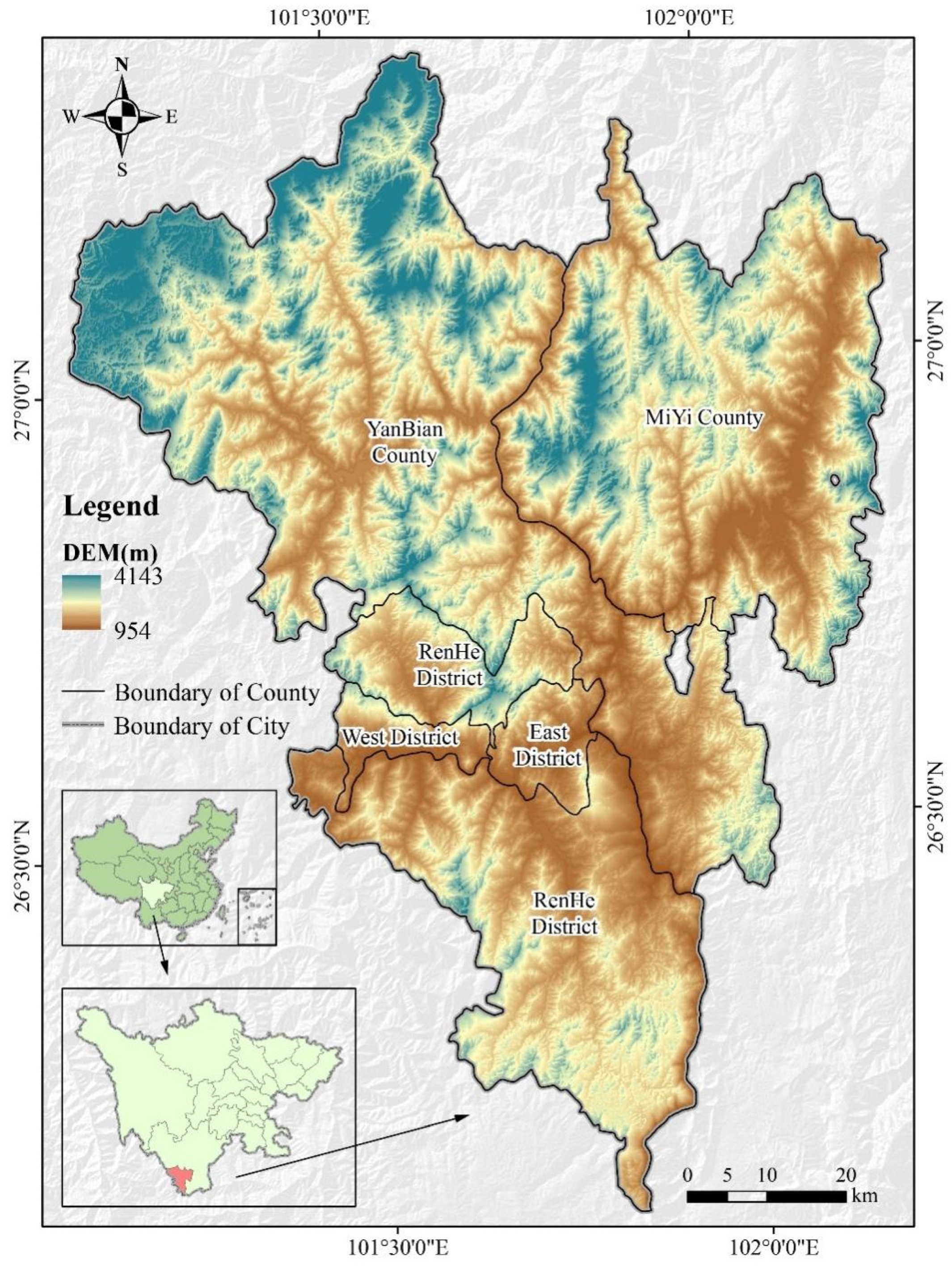
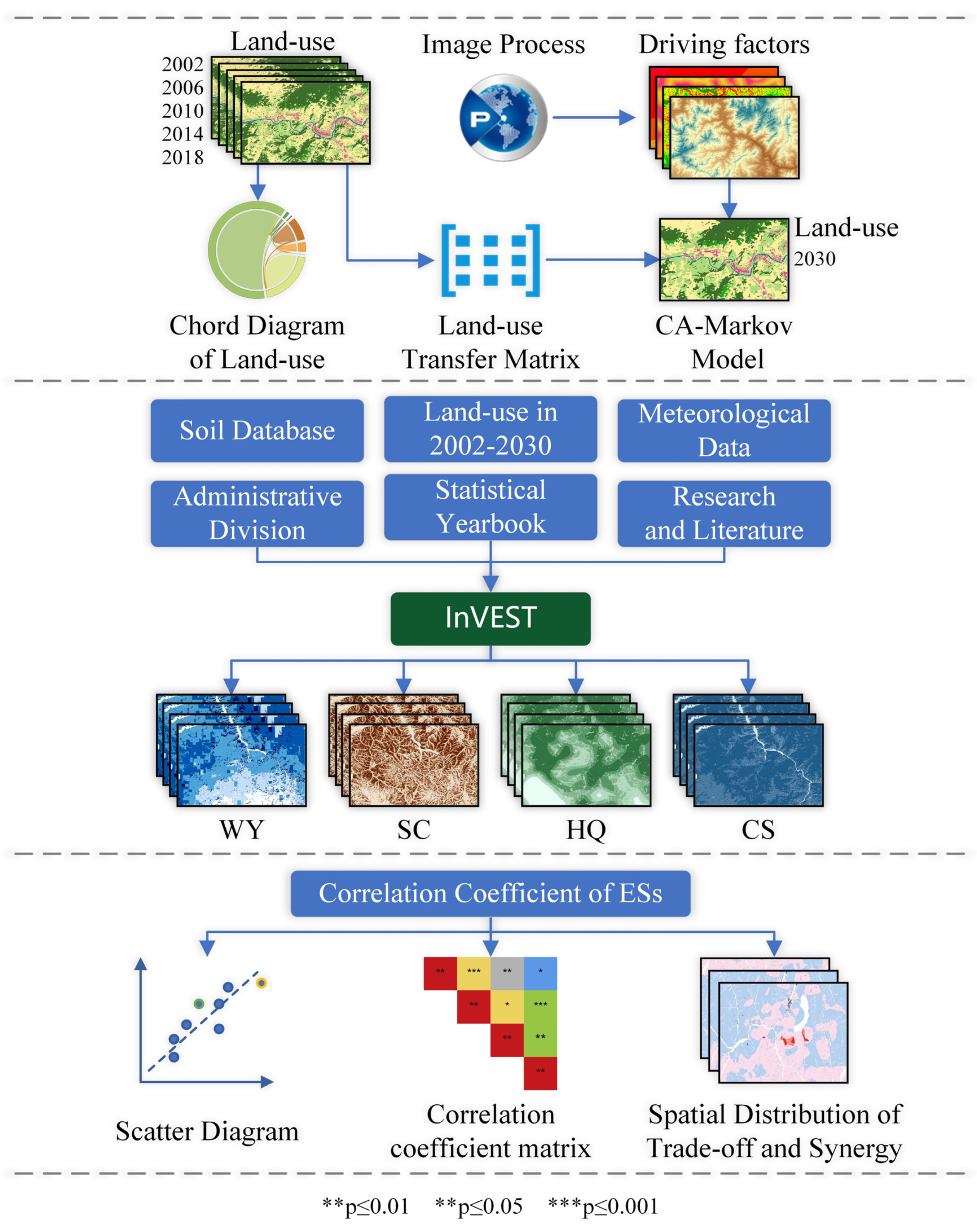
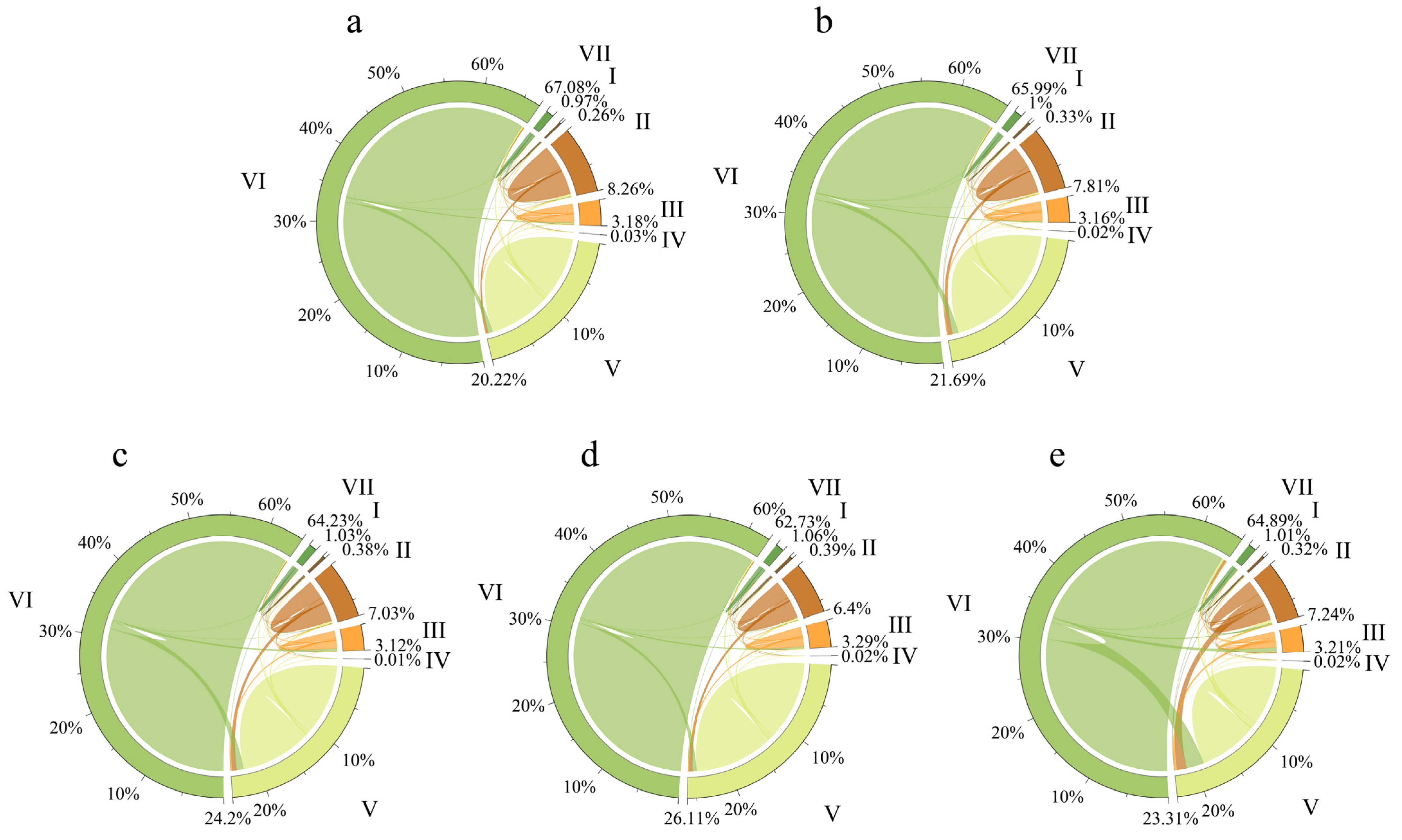
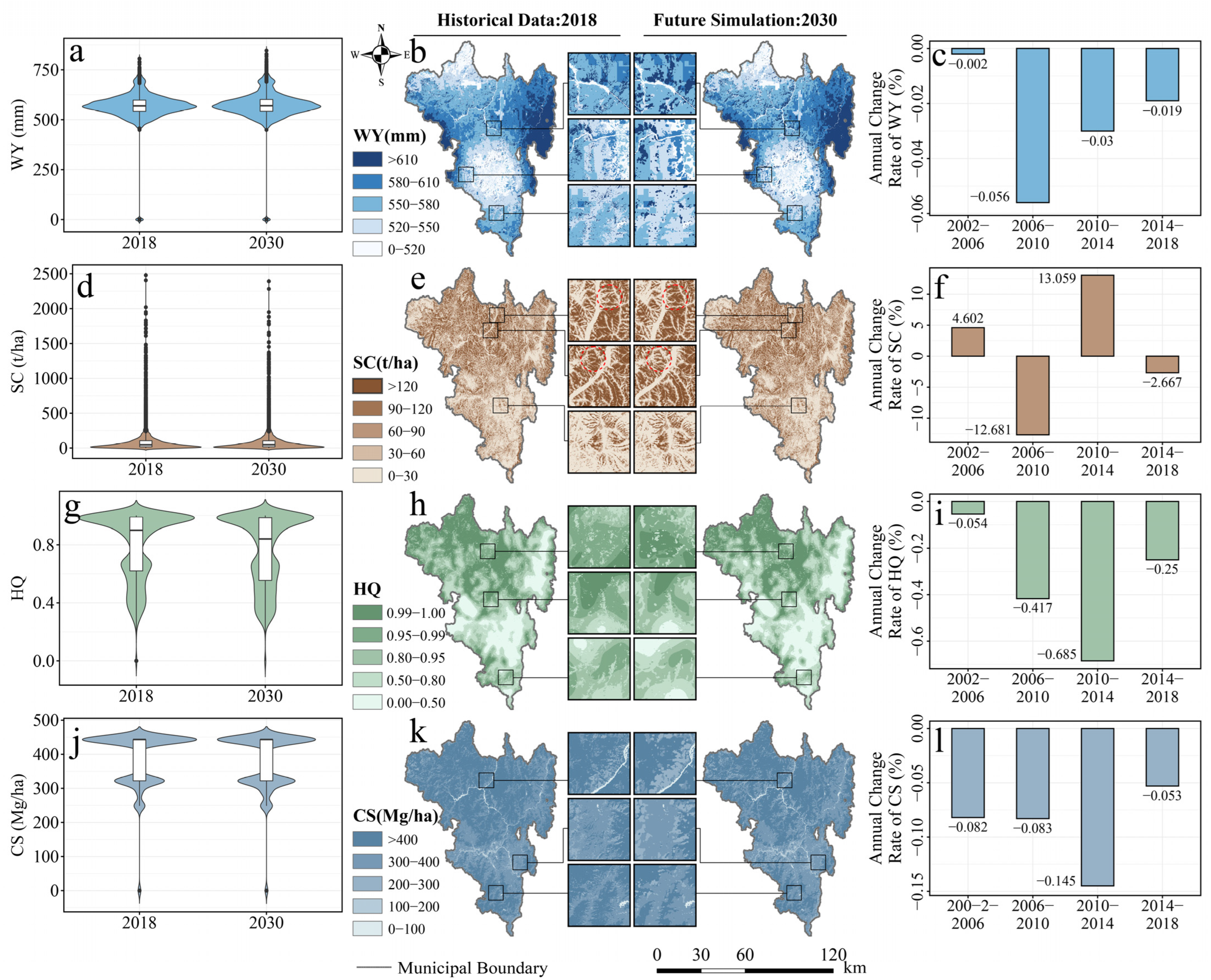
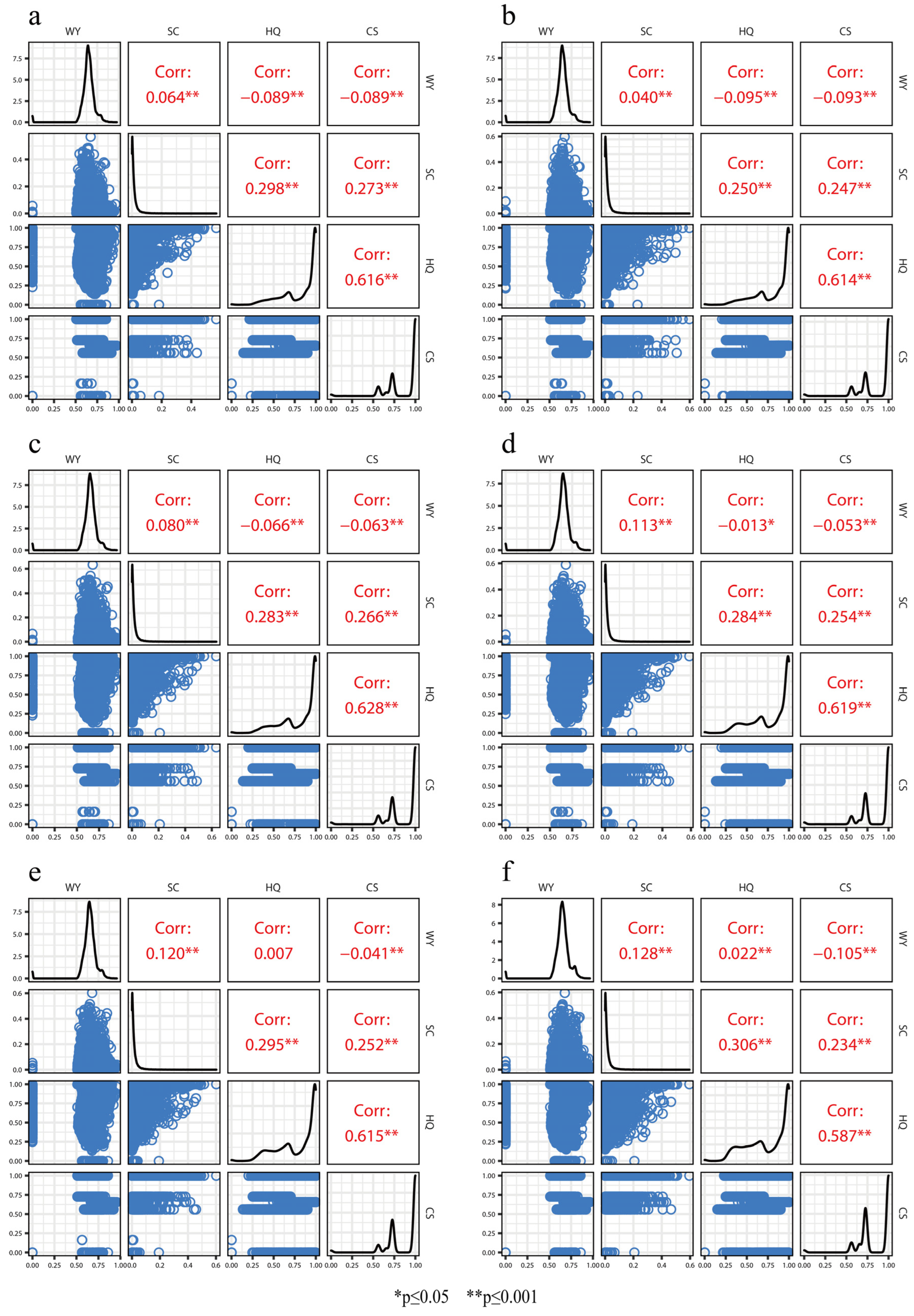
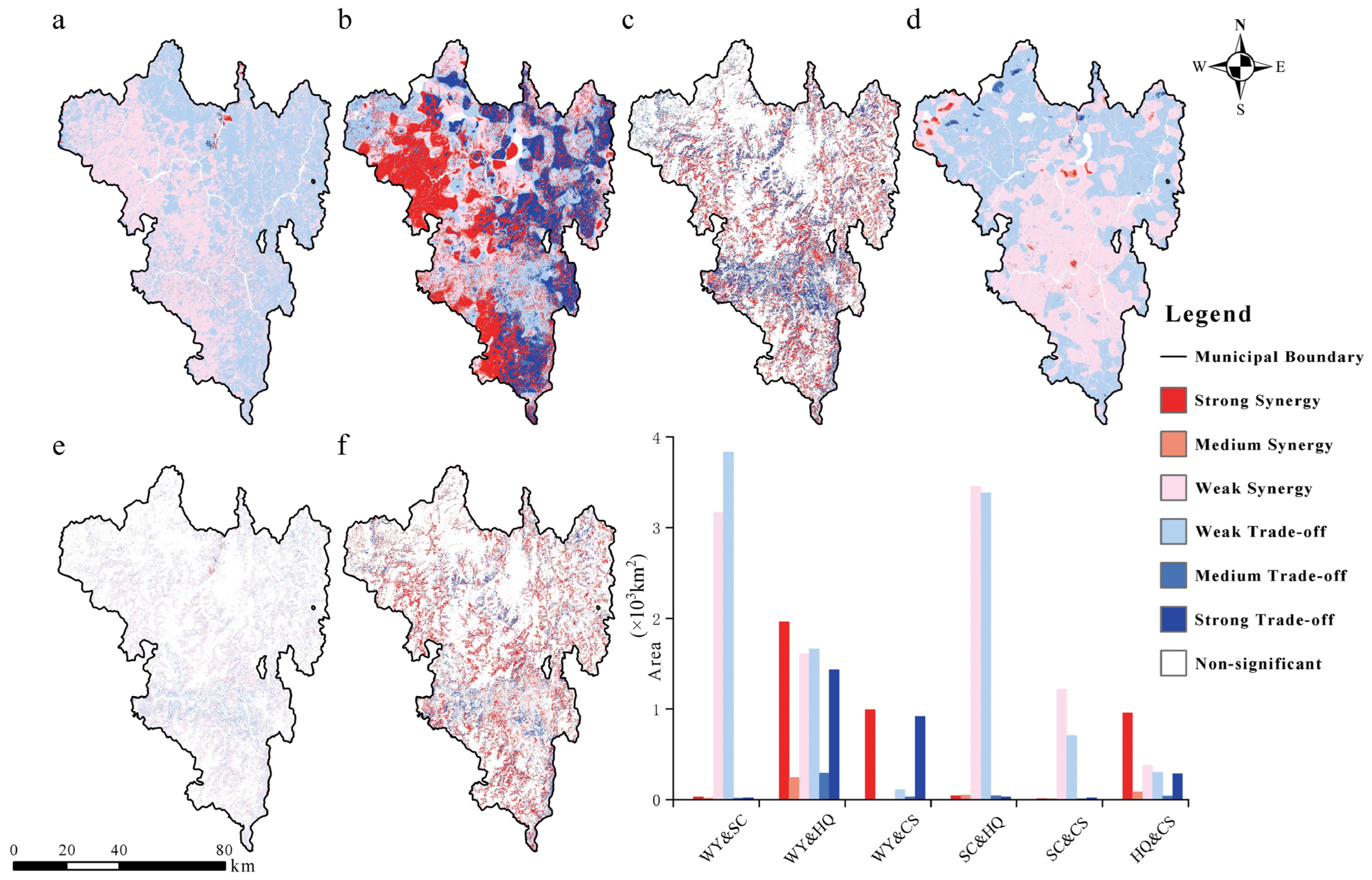


| Data | Spatial Resolution | Data Source | Index |
|---|---|---|---|
| 30 m annual land cover and its dynamics in China from 1990 to 2019 | 30 × 30 m | Data set produced by Professor Huang Xin’s team at Wuhan University [58] (https://zenodo.org/record/4417810#.YxhwS6HiviD (accessed on 9 December 2021.)) | Land use |
| ASTER GDEM V3 (30 m) | 30 × 30 m | Geospatial Data Cloud (http://www.gscloud.cn/ (accessed on 20 January 2022.)) | Digital elevation model (DEM) |
| Slope grids of study area | |||
| Watersheds | |||
| Distance to rivers | |||
| 1:250,000 road traffic data set of Sichuan Province | 1:250,000 | National Earth System Science Data Center (http://www.geodata.cn/ (accessed on 3 March 2022.)) | Distance to roads |
| Distance to railway | |||
| Distribution data of 1:250,000 rural residential areas in Sichuan Province | Distance to residential areas | ||
| Global Aridity Index and Potential Evapotranspiration Database | 30 × 30 arc-second | CGIAR CSI (https://cgiarcsi.community/ (accessed on 27 January 2022.)) | Potential evapotranspiration |
| Harmonized World Soil Database v 1.2 | 1 km × 1 km | Food and Agriculture Organization of the United Nations (https://www.fao.org/ (accessed on 23 January 2022.)) | Sand, silt, clay, and soil organic carbon content |
| Dataset of soil properties for land surface modeling over China | 30 × 30 arc-second | Big Earth Data for Three Poles (http://poles.tpdc.ac.cn/ (accessed on 27 January 2022.)) | Soil organic matter content |
| Hourly observation data of China’s ground meteorological stations | Forms of report | China Meteorological Data Service Centre (http://data.cma.cn/ (accessed on 21 January 2022.)) | Daily rainfall grid |
| Average annual precipitation grid | |||
| Statistical Yearbook of Sichuan Province | City level | Sichuan Provincial Bureau of Statistics (http://tjj.sc.gov.cn/ (accessed on 28 September 2021.)) | Annual precipitation in the study area |
| China Climate Bulletin | Country level | China Meteorological Administration (http://www.cma.gov.cn/ (accessed on 21 January 2022.)) | Annual precipitation in China |
| Mine environment monitoring data in Sichuan Province | Polygon feature | Sichuan Geological Survey (http://www.scddy.com.cn/ (accessed on 31 July 2019)) | Vector mineral data |
| A daily 0.25° × 0.25° hydrologically based land surface flux dataset for conterminous China, 1961–2017 [59] | 0.25° × 0.25° | Science Data Bank (https://www.scidb.cn/en (accessed on 28 January 2022.)) | River runoff |
| 2006 IPCC Guidelines for National Greenhouse Gas Inventories | Forms of report | IPCC (https://www.ipcc.ch/ (accessed on 15 February 2022.)) | Carbon density of dead matter |
Publisher’s Note: MDPI stays neutral with regard to jurisdictional claims in published maps and institutional affiliations. |
© 2022 by the authors. Licensee MDPI, Basel, Switzerland. This article is an open access article distributed under the terms and conditions of the Creative Commons Attribution (CC BY) license (https://creativecommons.org/licenses/by/4.0/).
Share and Cite
Zeng, J.; Xu, J.; Li, W.; Dai, X.; Zhou, J.; Shan, Y.; Zhang, J.; Li, W.; Lu, H.; Ye, Y.; et al. Evaluating Trade-Off and Synergies of Ecosystem Services Values of a Representative Resources-Based Urban Ecosystem: A Coupled Modeling Framework Applied to Panzhihua City, China. Remote Sens. 2022, 14, 5282. https://doi.org/10.3390/rs14205282
Zeng J, Xu J, Li W, Dai X, Zhou J, Shan Y, Zhang J, Li W, Lu H, Ye Y, et al. Evaluating Trade-Off and Synergies of Ecosystem Services Values of a Representative Resources-Based Urban Ecosystem: A Coupled Modeling Framework Applied to Panzhihua City, China. Remote Sensing. 2022; 14(20):5282. https://doi.org/10.3390/rs14205282
Chicago/Turabian StyleZeng, Jianwen, Jipeng Xu, Wenyu Li, Xiaoai Dai, Jiayun Zhou, Yunfeng Shan, Junjun Zhang, Weile Li, Heng Lu, Yakang Ye, and et al. 2022. "Evaluating Trade-Off and Synergies of Ecosystem Services Values of a Representative Resources-Based Urban Ecosystem: A Coupled Modeling Framework Applied to Panzhihua City, China" Remote Sensing 14, no. 20: 5282. https://doi.org/10.3390/rs14205282
APA StyleZeng, J., Xu, J., Li, W., Dai, X., Zhou, J., Shan, Y., Zhang, J., Li, W., Lu, H., Ye, Y., Xu, L., Liang, S., & Wang, Y. (2022). Evaluating Trade-Off and Synergies of Ecosystem Services Values of a Representative Resources-Based Urban Ecosystem: A Coupled Modeling Framework Applied to Panzhihua City, China. Remote Sensing, 14(20), 5282. https://doi.org/10.3390/rs14205282







